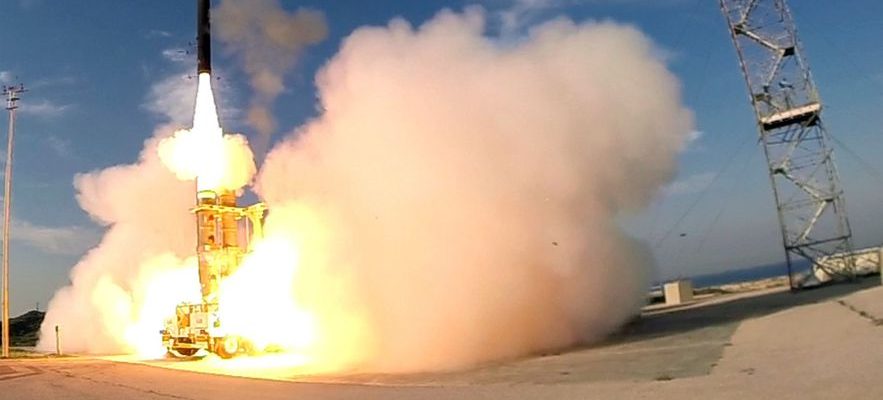A flood of fire. More than 1,400 rockets were launched against Israel in mid-May, from Gaza, by the Palestinian armed organization Islamic Jihad. However, they only caused one death, an 82-year-old Israeli woman whose apartment was hit head-on. Israel owes this relatively low record to its “Iron Dome”, whose success rate exceeds 90%. This system destroyed nearly 450 rockets fired by the Palestinian group in the air. The others, which did not threaten inhabited areas, were spared, to keep as many interceptors as possible for future attacks.
In two decades, Israel has developed recognized know-how in air protection, of which the “Iron Dome” is the most famous example. The war in Ukraine now allows it to monetize its systems, considered among the most effective in the world and bearing, for the most part, the precious label “combat comes” (proven in combat). Determined to better protect themselves from the Russian threat, Europeans are placing orders with a growing Israeli defense industry – a record $12.5 billion in exports in 2022.
Finland, which shares more than 1000 kilometers of borders with Russia, has just ordered “David’s Sling” (David’s Sling) for 316 million euros, after examining the different high altitude systems available on the market. Manufactured by the Israeli industrialist Rafael, like the “Iron Dome”, this defensive weapon can counter cruise missiles, drones and rockets at a distance of between 40 and 300 kilometers. Since May, she has been “combat proven”; two Islamic Jihad rockets targeting Tel Aviv were then intercepted in flight.
“Everything we produce must be the best in the world,” says Rafael’s president, Yuval Steinitz, in reference to the constant threats at the country’s borders (Hezbollah, Syria, Palestinian terrorist groups, Iran). We are now working on two new tools: a hypersonic missile interceptor, the Sky Sonic, and the “Iron Beam” laser, which must complete the “iron dome”. Our systems are game changers in any conflict”. Only one condition for its export: having the green light from the Israeli government, which is Rafael’s sole shareholder.
Ukraine is well placed to know how essential the approval of the Israeli government is. Lacking anti-aircraft defense against Russian missiles and drones, it insists that the latter provide it. France has already delivered Crotale and Samp-T to the Ukrainians; and Germany, Iris-T and Gepard. But for fear of undermining its agreements with the Russian army concerning strikes in Syria, Israel refuses to do so. Jerusalem also rejects the request from the Americans who would like to cede to kyiv the two “Iron Dome” batteries currently in Washington’s possession – here too, a green light from the Israelis is necessary. “We are concerned about the possibility that the systems that would be given to Ukraine could fall into the hands of Iran [en étroite relation avec Moscou]”, Prime Minister Benjamin Netanyahu justified himself.
The Arrow 3, a criticized choice
The “Iron Dome” and the “David’s Sling” are not the only systems to interest Europeans. As part of its European Sky Shield Initiative (ESSI, for European Sky Shield Initiative), launched in the fall of 2022, Germany has decided to entrust its exoatmospheric defense – above the layer of the atmosphere – to the Arrow 3, an interceptor co-developed by Israel and the United States to counter certain Iranian ballistic missiles. Manufactured by Israel Aerospace Industries (IAI), it must complement the deployment of the German Iris-T, for the lower terrestrial layers, and that of the American Patriot long-range system, higher up. This is the largest defense contract ever signed by Israel, worth 3.5 billion euros.
Archive photo released on December 10, 2015 by the Israeli Ministry of Defense showing a test of the Arrow 3 anti-missile system in an unspecified location south of Tel Aviv in Israel
© / afp.com/HO
“We are the only ones on the market against ballistic missiles and we have been discussing with Berlin for several years, confides the president of IAI, Boaz Levy, met at the company’s headquarters, next to Ben Gurion airport. Our neighborhood requires that we find solutions to all kinds of threats, which are now affecting Europe.” This choice of Arrow 3 was, however, criticized by France. It refused to join the ESSI (19 member states), judging that it gave too much emphasis to German and non-European technologies even though it would have been more interesting, in the long term, to develop an equivalent. ruler of the Arrow 3.
For the French, there is no urgency. Certainly, “the Arrow 3s have the capacity to intercept the Russian hypersonic Kinzhal missiles, whose course is partly ballistic”, as underlines Uzi Rubin, father of the Arrow programs and specialist in anti-missile systems at the Jerusalem Institute for Defense. strategy and security. But the war in Ukraine shows that the Kinzhals can be destroyed by the Patriots, which Germany already has. “If there is a need to strengthen the air shield well supported by the Iris-T and the Patriot, it is not clear what other threats Berlin wants to counter with the Arrow 3, notes researcher Lydia Wachs, author of a recent study on ESSI. But it is true that there is little public data on the exact characteristics of this system.
Boaz Levy defends the merits of this acquisition: “The Arrow 3 can be modified depending on the threats.” These are likely to expand in the years to come. Russia could relaunch its production of intermediate-range missiles (500 to 5,500 kilometers). Signed after the Euromissiles crisis (1977-1987), the American-Russian treaty banning their production has expired. Germany could seek to protect itself from this potentially atomic danger. However, “the Arrow 3 was designed to destroy nuclear warheads still in space, where their explosion would minimize physical damage on the ground,” underlines Uzi Rubin. A crucial detail for a territory like Israel, smaller than Brittany.
